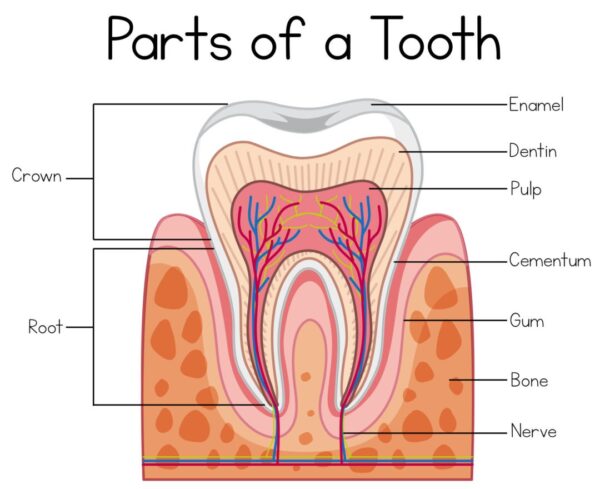
Our teeth are an active part of our digestive system. Teeth dissolve foods before you swallow. On average, most adults have 32 teeth, although some adults have more or less teeth. Enamel is primary protective part of your teeth. Within the human body, enamel is the toughest substance.
Understanding the different parts of your teeth is important for maintaining good oral hygiene and for preventing severe dental disease. Regular dental care and proper oral hygiene practices are essential to keep your teeth healthy and functioning properly.
What are teeth?
Teeth are hard, calcified structures found in the mouths of vertebrates. Adult teeth are also known as permanent teeth. They are primarily used for biting, chewing, and grinding food. The main function of teeth is to break down food into smaller pieces, making it easier to swallow and digest.

How many teeth do we have?
Permanent adult teeth on average consist of 32 teeth. The 32 teeth are made up of incisor teeth, canine teeth, premolars, molars, and wisdom teeth. If your wisdom teeth have been removed, you will probably have 28 teeth.
How many roots does each tooth have?
Each tooth has a different number of roots. Typically incisor, canine and premolar teeth will have one root whereas molar teeth will have two or three.
What are teeth made of?
- Tooth Enamel
- Tooth Dentin
- Tooth Pulp
- Tooth Root
- Tooth Cementum
- Periodontal Ligament
- Tooth Crown
Enamel:
Enamel is the outermost layer of your teeth and is the hardest and most mineralized substance in the human body. It provides protection and acts as a barrier against decay and damage.
Dentin:
Dentin is the layer beneath the enamel and makes up the bulk of the tooth’s structure. It is a hard tissue but not as hard as enamel. Dentin contains tiny tubules that transmit sensations like temperature and pain to the nerve in the pulp.
Pulp:
The pulp is the innermost part of the tooth, located at the center. It contains blood vessels, nerves, and connective tissues. The pulp is responsible for nourishing the tooth and transmitting sensory information, such as pain and temperature sensitivity.
Root:
The root of a tooth extends below the gumline and anchors the tooth in the jawbone. Teeth can have one or more roots depending on their type. Molars typically have more roots than front teeth, for example.
Cementum:
Cementum is a calcified tissue that covers the tooth’s roots. It helps anchor the tooth within the jawbone by attaching to the periodontal ligament, which connects the tooth to the bone.
Periodontal Ligament:
The periodontal ligament is a group of fibers that attach the cementum to the jawbone. It provides support and allows the tooth to absorb the forces exerted during chewing.
Crown:
The crown is the visible part of the tooth that is above the gumline. It’s the part of the tooth that you see when you smile, and it is covered by enamel.
Tooth Hygiene & Care
Teeth hygiene and care are essential for several reasons:
Prevention of Dental Problems: Good dental hygiene helps prevent common dental problems such as cavities (dental caries), gum disease, and bad breath (halitosis). Regular brushing and flossing remove plaque and food particles that can lead to tooth decay and gum disease if left untreated.
Maintenance of Oral Health: Proper dental care promotes overall oral health by keeping the teeth and gums clean and healthy. This reduces the risk of developing oral health issues and helps maintain the function of the teeth for chewing and speaking.
Prevention of Tooth Loss: Dental hygiene plays a crucial role in preventing tooth loss. Gum disease, which is often caused by poor oral hygiene, is a leading cause of tooth loss in adults. By maintaining good dental hygiene practices, you can reduce the risk of gum disease and preserve their natural teeth for as long as possible.
Enhancement of Aesthetic Appearance: Good dental hygiene contributes to a pleasing smile and overall facial appearance. Clean, healthy teeth and gums can boost self-confidence and improve social interactions.
Overall, teeth hygiene and care are crucial for maintaining oral health, preventing dental problems, preserving natural teeth, and promoting overall well-being. By incorporating good dental hygiene practices into their daily routine and seeking regular dental care, you can enjoy the benefits of a healthy smile and improved quality of life.
Types of Adult Teeth
Adults have four types of teeth, each serving different functions in the chewing and digestion process. These types of teeth are:
Incisors: Incisors are the eight front teeth located in the upper and lower jaw. There are four incisors in each jaw, two central incisors, and two lateral incisors. Incisors are sharp-edged teeth used for cutting and biting into food. They play a crucial role in the initial stages of the chewing process.
Canines: Canines, also known as cuspids, are the four pointed teeth located next to the incisors, two in the upper jaw and two in the lower jaw. Canines have a pointed shape and are used for tearing and shredding food. They are particularly effective for ripping into tougher foods.
Premolars: Premolars, also called bicuspids, are the eight teeth located behind the canines, two in each quadrant of the mouth (upper and lower jaw on both sides). Premolars have flat surfaces with two or more cusps and are used for grinding and crushing food. They have a more complex structure compared to incisors and canines.
Molars: Molars are the twelve teeth located at the back of the mouth, three in each quadrant (upper and lower jaw on both sides). They are the largest and strongest teeth in the mouth, with broad, flat surfaces covered in multiple cusps. Molars are primarily responsible for grinding and chewing food into smaller pieces before swallowing.
These four types of teeth work together to facilitate the chewing and digestion process, enabling the breakdown of food into smaller, more manageable pieces for digestion and nutrient absorption. Each type of tooth is specialized for a specific function, contributing to overall oral health and proper functioning of the digestive system.

